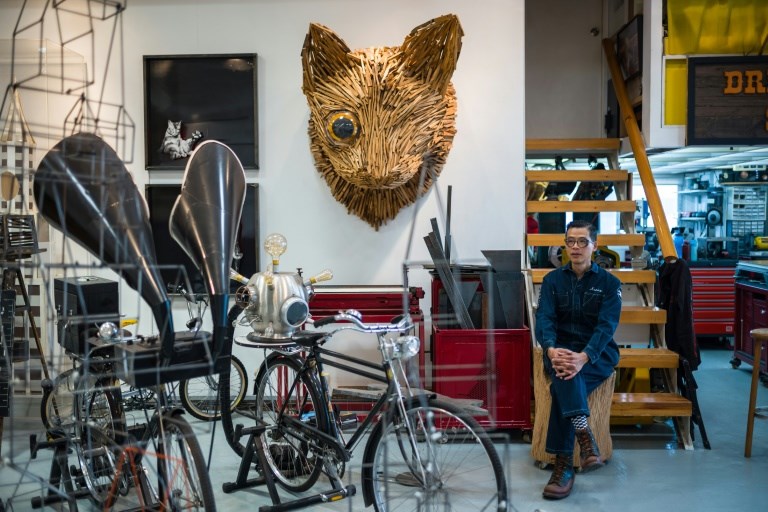At a sunny Hong Kong art studio Kacey Wong gazes out through the bars of a cage, painted communist red -- his work a protest in a city struggling to square its vast cultural ambitions with an increasingly assertive Beijing.
Better known for its high-end commercial galleries -- and glamourous fairs like this month's Art Basel -- Hong Kong is striving to turn itself into a cultural heavyweight through a spate of new multi-million-dollar public art spaces.
But local artists warn Beijing's growing influence is creating a climate of fear that is stifling creativity and threatens the nascent grassroots art scene Hong Kong says it wants to enrich.
"The way I look at it is that all government-supported art space... is already not safe," said Wong, who sat in his cage outside Hong Kong's government headquarters last July 1 -- the anniversary of the city's return to China by Britain.
"The red line is invisible and it's shifting all the time," Wong, 49, told AFP.
Hong Kong has rights unseen on the mainland but fears they are being steadily eroded were compounded last year when a highly-anticipated show by Chinese political cartoonist Badiucao was cancelled, with organisers citing threats made by the Chinese authorities.
Talks by dissident author Ma Jian were pulled just a week later by the new Tai Kwun arts centre, before being reinstated at the last moment.
The freedom of the city's publishing has also taken a hit, with five booksellers known for printing gossipy titles about China's leaders disappearing in 2015 and resurfacing in custody on the mainland.
- 'Obedient artists' -
The unprecedented challenges to freedom of expression come at a time of staggering public investment in Hong Kong arts and culture.
As well as Tai Kwun -- a $484 million renovation of a former colonial prison and police station led by The Hong Kong Jockey Club in partnership with the government -- there is the 60,000-square-metre harbourfront M+ gallery due to open in 2020.
M+ and the Xiqu centre, a recently-opened Chinese opera venue, are part of the vast West Kowloon Cultural District costing upwards of $2.8 billion.
The city's Chief Executive Carrie Lam has said that West Kowloon's success would "elevate the status of Hong Kong to among the great cities of the world".
But others fear Hong Kong could follow the model of Singapore, which has a thriving, government-supported arts scene but is at the mercy of authorities who can withhold or withdraw funding if work is deemed to breach their guidelines.
Critics say this pushes locally-based creatives to self-censor and avoid delving too deeply into topics deemed sensitive by the government.
"Tai Kwun and West Kowloon will provide opportunities," said Wen Yau, who researched artist participation in social movements as part of a PhD at Hong Kong Baptist University.
"So it's quite an easy way to get all these people in and they will be obedient artists because once you depend on the funding it's hard to say no."
Cosmin Costinas -- the director of Para Site, one of Hong Kong's oldest contemporary art centres -- said the city's artists were not yet self-censoring, but admitted censorship was a problem, albeit one caused primarily by middle men.
"I think it's important to understand that the majority of them (censorship cases) have not come directly from sources of power but from different intermediaries that were themselves afraid," he said.
His words echoed the experience of AFP.
West Kowloon's press office refused to allow directors at M+ and the Xiqu centre to be interviewed on this subject and a Tai Kwun press officer also turned down an interview on behalf of Tobias Berger, head of arts.
One exception was Eve Tam, director of the Hong Kong Museum of Art -- due to reopen later this year after a revamp -- who said she would give "freehand to the artist to have their own position" on sensitive issues.
- 'Can't help their homeland' -
Still, some creatives aren't taking any chances.
"Some of my artist friends moved away, to Germany and to Taiwan. They don't want to stay in Hong Kong," said Man Chan, 32, an artist and assistant at Wong's studio.
"Of course they are angry but how however hard they try they can't help their homeland. So they just go."
Even among those who remain in Hong Kong, some have sent their work abroad.
Last year hand-drawn sketches of Hong Kong's 2014 Umbrella Movement -- month's-long pro-democracy demonstrations -- were part of an exhibition on dissent at London's British Museum.
M+ told AFP at the time it was still "carefully evaluating this recent past" and was not considering the works for its collection.
But there are young artists in Hong Kong who are still fighting on their home turf.
"I've always been someone who cares about Hong Kong and an artist who's willing to discuss these topics through my creations," said Siu Wai-hang, 32, whose video work depicting the July 1 pro-democracy protest won the Hong Kong Human Rights Art Prize in 2018.
Wong agrees.
"Don't think people will just totally give up and won't do anything even in a super suppressive regime. People will be doing Banksy-like (works). There'll be invisible platforms."



